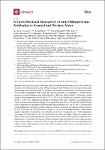A Cross-Sectional Serosurvey of Anti-Orthopoxvirus Antibodies in Central and Western Africa
Leendertz, Siv Aina J.
Stern, Daniel
Theophil, Dennis
Anoh, Etile
Mossoun, Arsène
Schubert, Grit
Wiersma, Lidewij
Akoua-Koffi, Chantal
Couacy-Hymann, Emmanuel
Muyembe-Tamfum, Jean-Jacques
Karhemere, Stomy
Pauly, Maude
Schrick, Livia
Leendertz, Fabian H.
Nitsche, Andreas
Since the eradication of smallpox and the subsequent discontinuation of the worldwide smallpox vaccination program, other Orthopoxviruses beside Variola virus have been increasingly representing a risk to human health. To investigate the extent of natural contact with Orthopoxviruses and possible demographic risk factors for such an exposure, we performed a cross-sectional serosurvey of anti-Orthopoxvirus IgG antibodies in West and Central Africa. To this end, people living in forest regions in Côte d’Ivoire (CIV, n = 737) and the Democratic Republic of the Congo (COD, n = 267) were assigned into groups according to their likely smallpox vaccination status. The overall prevalence of anti-Orthopoxvirus antibodies was 51% in CIV and 60% in COD. High rates of seropositivity among the vaccinated part of the population (80% in CIV; 96% COD) indicated a long-lasting post vaccination immune response. In non-vaccinated participants, seroprevalences of 19% (CIV) and 26% (COD) indicated regular contact with Orthopoxviruses. Multivariate logistic regression revealed that the antibody level in the vaccinated part of the population was higher in COD than in CIV, increased with age and was slightly higher in females than males. In the unvaccinated part of the population none of these factors influenced antibody level significantly. In conclusion, our results confirm expectedly high anti-Orthopoxvirus seroprevalences in previously smallpox-vaccinated people living in CIV and the COD but more unexpectedly imply regular contact with Orthopoxviruses both in Western and Central Africa, even in the absence of recognized outbreaks.
No license information

